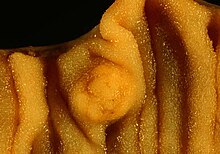| Small intestine cancer | |
|---|---|
| Other names | Small bowel cancer, cancer of the small bowel |
 | |
| Picture of a carcinoid tumour that encroaches into lumen of the small bowel. Pathology specimen. The prominent folds are plicae circulares, a characteristic of small bowel. | |
| Specialty | Gastroenterology, general surgery, oncology |
| Symptoms | vomiting blood, blood in the stool |
Small intestine cancer is a cancer of the small intestine. It is relatively rare compared to other gastrointestinal malignancies such as gastric cancer (stomach cancer) and colorectal cancer.[1][2]
Small intestine cancer can be subdivided into duodenal cancer (the first part of the small intestine) and cancer of the jejunum and ileum (the latter two parts of the small intestine). Duodenal cancer has more in common with stomach cancer, while cancer of the jejunum and ileum have more in common with colorectal cancer. Five-year survival rates are 65%.[3]
Experts[which?] believe that small intestine cancer develops much like colorectal cancer. It first begins as a small growth on the inner lining of the intestine (polyp), which over time becomes cancer. (American Cancer Society 2023)
Approximately 50% of adenomas of the small intestine arise in the duodenum even though this location comprises only 4% of the length of the small intestine. These adenomas occur mainly close to the ampulla of Vater, the outlet of the common bile duct from which bile acids are released.[4] This area is also closely associated with the pancreas, so they are treated as pancreatic cancer.
The small intestine works by mixing food and gastric juices into a thick fluid in the stomach and then emptied into the small intestine. It then continues to break down and absorb the nutrients. Although it is referred to as the small intestine, it is the longest section of the GI tract being approximately 20 feet long. The length of the small intestine comprises 75% of the length of the entire gastrointestinal tract[5]
There are three parts of the small intestine. The duodenum is the 1st section of small intestine and only about a foot long. The jejunum and ileum make up most of the small intestine. Most of the nutrients in food are absorbed into the bloodstream in these two parts. (American Cancer Society 2023)
- ^ "Gastric Cancer". The Lecturio Medical Concept Library. Retrieved 22 July 2021.
- ^ "Colon Cancer Treatment (PDQ®)". NCI. May 12, 2014. Archived from the original on July 5, 2014. Retrieved June 29, 2014.
- ^ "SEER Stat Fact Sheets: Small Intestine Cancer". NCI. Retrieved 18 June 2014.
- ^ Ross RK; Hartnett NM; Bernstein L; Henderson BE. (1991). "Epidemiology of adenocarcinomas of the small intestine: is bile a small bowel carcinogen". British Journal of Cancer. 63 (1): 143–5. doi:10.1038/bjc.1991.29. PMC 1971637. PMID 1989654.
- ^ Maguire, A; Sheahan, K (2018). "Primary small bowel adenomas and adenocarcinomas-recent advances". Virchows Archiv. 473 (3): 265–73. doi:10.1007/s00428-018-2400-7. PMID 29998424.